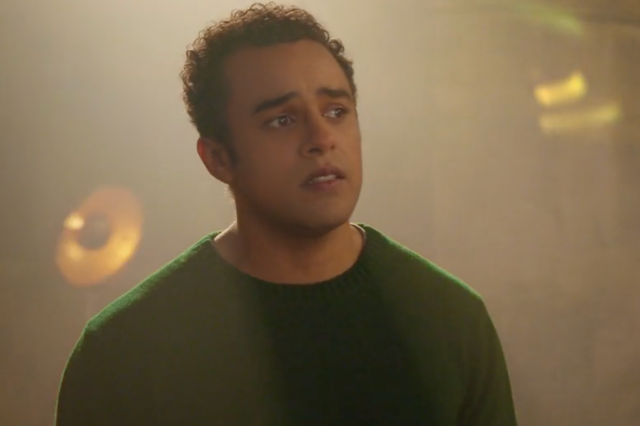WOS Radio: Sweet Charity Cast Quizzed at Q&A
Amid talk of a West End transfer (See The Goss, 19 Jan 2010), the director and stars of the Menier Chocolate Factory’s critically-acclaimed revival of Sweet Charity addressed the rumours – amongst many other things – during the post-show Q&A at our Whatsonstage.com Outing last night (26 January 2010).
Director Matthew White was joined during the discussion by cast members Tamzin Outhwaite (Charity Hope Valentine), Mark Umbers (Charlie/Vittorio/Oscar), Richard Roe (Young Man) and Richard Jones (Swing/Dance Captain), as well as assistant director Kate Golledge.
Other topics covered included the altered ending of the show, the decision to have Mark Umbers play all of Charity’s love-interests (the first time this has been done), and the sublime choreography of Stephen Mear.
Sweet Charity – which has music by Cy Coleman, lyrics by Dorothy Fields and a book by Neil Simon, with original direction and choreography by Bob Fosse – takes a look at the seedy underbelly of 1960s New York. The gullible, enchanting heroine Charity Hope Valentine dances, laughs and cries her way through a series of whirlwind romances to show-stopping numbers including “Rhythm of Life”, “If My Friends Could See Me Now” and “Hey Big Spender”.
On the magic of the Menier
Matthew White:It’s a mixture of things, it’s partly the intimacy of the space; from every seat you can really see faces. You’re much more connected than in a big West End House. It’s also partly the nature of where the building is and the fact that there is a trendy bistro here. It’s the whole package. There’s a lovely sort of off-Broadway informality to the building which I think really helps and it feels like you’re discovering something for the first time when you walk down this dimly lit passage. So I think that’s part of it and the intimacy is great, you feel like you’re really in there with the story.
Tamzin Outhwaite: Sometimes the audience being close to you really tests your concentration but the majority of the time I think it’s the best. You can see people enjoying it, and even though you’re trying not to look in people’s eyes you can see when people are really up for it. Sometimes you’ll be watching and there will be people who look like they’re not really enjoying it and then by the end they’re crying and clapping and you think ‘oh they were just concentrating’. I really like it, I love the intimacy of it, but some people find it scary.
Richard Roe: It’s a squeeze. If you get changed stage right you can’t cross the stage at all. You have to go outside. When it was snowing the poor girls were going out in their little dresses and their wigs so we tried during rehearsals to make sure that most of the changes were done on stage left because there’s a little corridor that goes behind the curtain that takes us backstage but it’s quite a squeeze.
Kate Golledge: The backstage traffic is meticulously choreographed. So when people go backstage they know exactly where they have to go for changes. There is as much choreography that you don’t see as you do see which makes for interesting watching if you are backstage.
On the choreography
Richard Jones : I think Stephen (Mear) wanted to keep certain elements of Bob Fosse’s choreography but obviously didn’t just want to recreate what had been done before. So there are a few tiny signature moves from Fosse’s choreography, such as the hand movement in “Big Spender” and of course the feel is the same but Stephen wanted to give it his own new angle and he has done.
Matthew White: It was easy with Stephen because he is an extremely good collaborator; he really enjoys the whole process of collaboration. He’s a very busy choreographer; he’s working on TV at the moment and is very much in demand. And yet during our rehearsal period he was there all the time. He was always inventing and searching and thoroughly involved in the project.
He’s a lovely person to work with and very creative. He was very excited about this project because he was being given the license to re-choreograph the show. I think they’ve kept a tight lid on it till now and they allowed us to do what we wanted with it which was fantastic.
On the transition from kitchen sink TV to stage musicals
Tamzin Outhwaite:I hadn’t been in a musical for 11 or 12 years so coming into this show was obviously terrifying because I didn’t think I would have the stamina. These guys do it for a living, but I didn’t feel like it was my living anymore. Working with Stephen again, because Stephen was one of my teachers at college, was great – I knew his style. And Nigel (Lilley) was brilliant. Plus, I thought if I don’t do it now a role like this is not going to come up again for me at my age.
Charity is an absolute gift of a role to play every day. And in musical theatre I don’t think there are that many that have such a journey from beginning to end; sing, dance, act and go through that whole plethora of emotions. She puts a brave face on everything and keeps smiling through everything despite having her heart broken on a daily basis, sometimes twice a day.
On Mark Umbers’ multiple roles
Matthew White: The idea came initially from me. I thought it felt very bitty reading it. I didn’t know the show terribly well but I just couldn’t envisage, particularly when doing it with a small company, having different actors playing Mark’s roles. It seemed to help to give a more cohesive feel to it. Also the fact that Charity, in our show, is the only person who plays one role – she is the pivot and everything else swirls around her so we wanted the Nickie and Helene actresses to have a noticeably different character to play. That was always part of the fun of it.
Mark Umbers: When I got an email about it from my agent I didn’t quite understand that they were looking for someone to play all the parts. When I read the script, I wasn’t sure about it, and was going to suggest to my agent that I would love to go in but only if I could play both of them. Fortunately, it turned out that was what Matthew was looking for.
On the rehearsal schedule
Matthew White: We had four weeks of rehearsal and we had Tamzin, Tiffany and Josefina for a little bit longer for the choreographic work so I’d say four and a half weeks. Then we went into our tech which was three or four days and then we did ten shows for previews. It was tight but we always knew how much time we had. So we motored through rehearsals and we were able to do quite a lot of split rehearsal so Stephen would be doing work upstairs and we’d be doing work down here. And there was so much stuff between Mark and Tamzin that it was quite easy to split rehearsals that way.
On the future of this production
Matthew White: It tends to be the producers and the money men that decide the future of these things, and also things like venue availability – I’m usually the last to know. There’s a lot of talk about taking it somewhere else but we’re still waiting on confirmation of that.
On the ending
SPOILER ALERT! The ending of the show is revealed in this section (which is not included on the recording).
Mark Umbers: The original is actually a lot more depressing than our version. Oscar goes mad and pushes her in the river, leaving her exactly back where she started.
Matthew White: This is actually the happiest ending the show’s ever had. The aim with our version isn’t to imply that she’ll end up happily ever after with the soldier, but at least to provide a glimmer of hope.
Kate Golledge: There’s a very strange bit in the original with a guardian angel turning up to save her from the river, who turns out to be doing a promotion for a company. We decided to cut that, and simplify it down.












